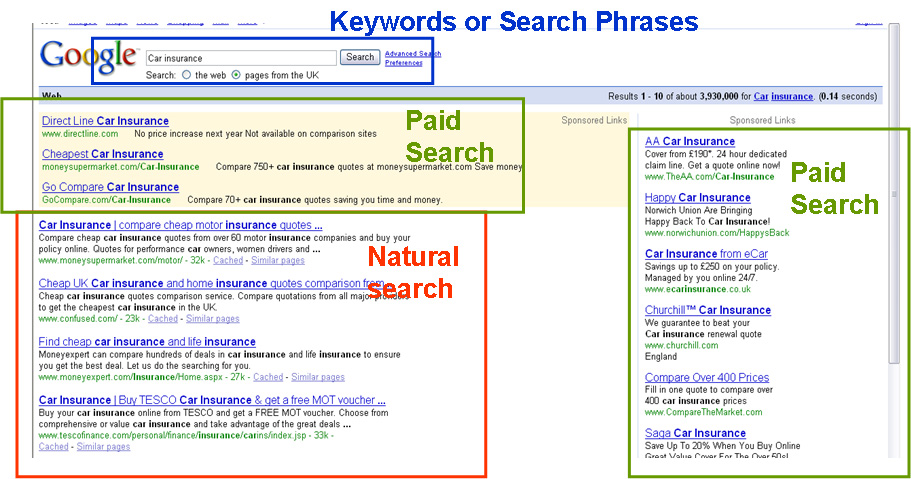Helping Your Micro-business Website to be Found
If you’ve built and created a website, you want people to visit it. Search Engine Optimisation (SEO) is the combination of techniques that enable your site to be found when someone uses a search engine such as Google.
First of all, a word of warning. SEO is time-consuming with no guarantee of success and is prone to the modern-day equivalent of ‘snake-oil salesmen’ who will take your money with no real return. If anyone promises to get you to the top of Google then keep your money in your pocket, because they cannot give this guarantee via Search Engine Optimisation. Instead they will be using Pay-per-Click Advertising for short-term returns.
Similarly, if they promise links that will boost your search engine position then run a mile. They are promoting ‘link-farms’ which will most likely damage your search engine ranking, rather than boost it.
How Search Engines Work
Search engines use an ‘algorithm’, or a set of rules, to determine whether a site ranks highly on page 1, or languishes somewhere on page 275. However, they will not reveal exactly what their algorithm is. Instead, there is a set of best practises that can be followed to improve the likelihood of a high ranking. The greater number of practises that are followed, and the length of time these practises have been followed for, the higher up the rankings the site will be.
Google and the other search engines rank sites by trawling the internet to see what’s available then, in effect, they score each one based on the number of best practises it follows. It will also determine what it believes the site is about in a process called ‘indexing’. When someone keys a phrase into the search box, the search engine looks at its index and returns the sites it believes best meets what the searcher is really looking for, ranked according to how well it believes each site meets the needs of the searcher.
There are three main best practise areas to concentrate on with SEO; content, meta details and inbound links.
Optimising Content
as Google indexes sites based on how well they appear to meet a searcher’s needs, content is absolutely vital. To rank well, a site needs at least 4-6 pages with a minimum of 400 words in each. Then Google knows that there is sufficient content to make the site worth considering.
The content also needs to be relevant. Think about what a searcher is really looking for, then build the words on the page around it. Think in terms of ‘keywords’, which is what the page or site is really about. So if I wanted to optimise well for the keywords ‘Search engine optimisation’, I would make sure that the reader knew that the page was about search engine optimisation by using the phrase ‘search engine optimisation’ in as many relevant ways as possible.
If I also wanted to optimise well for pay-per-click I would have a separate page for pay-per-click which specifically discussed pay-per-click.
I wouldn’t overdo the keywords on the page though, as I want the reader to be able to read the content without being overwhelmed by a repetitive phrase.
Meta Details
These tell both the search engine and the searcher what a site is about. The image below represents what a typical search may provide. Notice first of all that there are two types of result; paid for adverts and natural search. SEO is about ranking highly in the natural search element.
On each page there are around 10 entries of natural search and several more of paid adverts. As a searcher I will only look at some of them, so I want an indicator of which best suit my needs before I click on them. Meta details do this and there are two kinds; Titles and Descriptions as shown below.
There are a limited number of characters for each so write them in such a way that a searcher knows why they should pick your company rather than someone else listed in the results. Pick out your Unique Selling Point (USP) and emphasise that. If you want some guidance on finding a USP, read Unique Selling Points.
Inbound Links
If a friend were to make a recommendation to you about a company to use, you would normally listen. By the same token, if a site highly regarded by Google links to your site, Google is going to think that your site is good quality and worth considering. This is the nature of inbound links – high-quality rubs off on you. But it really is about quality, rather than quantity. The problem with link-farms is that they concentrate on the volume of links, not how good they are.
Examples of highly-regarded sites include academic institutions (a suffix that ends in .ac.uk), government bodies (suffixes end in .gov or .gov.uk), respected organisations (often ending in .org or .org.uk), trade bodies and recognised industry leaders. So I’ve made sure that the institutions I teach at (Manchester Metropolitan University and the Oxford College of Marketing), trade bodies I’m a member of (Chartered Institute of Marketing and the Institute of Direct and Digital Marketing) and other respected bodies (such as my local Chamber of Commerce) all have links in their site pointing to mine.
Making SEO Happen
Search engine optimisation is not a one-off activity, it needs to be an ongoing process. Making useful, relevant amends to your site regularly tells Google that it is loved and cared for, so worthy of their attention. Those without regular updates can be seen as neglected. You need to be in it for the long term to make a success of it.
Think about what you want to be found for in searches. You won’t be found for every single keyword relevant to your industry or micro-business, so choose carefully and concentrate on those. Different ways of doing this are explored further in Developing a Search Engine Approach.
Finally, unless you know and understand coding, use a professional SEO consultant or web designer to help you. A lot of SEO activity involves amending the coding of the site, so you need to know what you are doing before making changes. Remember also that your web designer may be able to make very pretty websites but SEO is a different skill, one they might not have.




